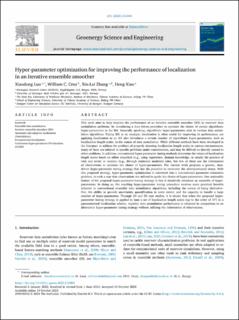| dc.contributor.author | Luo, Xiaodong | |
| dc.contributor.author | Chalub Cruz, William | |
| dc.contributor.author | Zhang, Xin-Lei | |
| dc.contributor.author | Xiao, Heng | |
| dc.date.accessioned | 2024-04-11T07:56:56Z | |
| dc.date.available | 2024-04-11T07:56:56Z | |
| dc.date.created | 2023-11-01T10:07:30Z | |
| dc.date.issued | 2023 | |
| dc.identifier.citation | Luo, X., Cruz, W.C., Zhang, X-L. & Xiao, H. (2023) Hyper-parameter optimization for improving the performance of localization in an iterative ensemble smoother. Geoenergy Science and Engineering, 231, Part B, 212404 . | en_US |
| dc.identifier.issn | 2949-8929 | |
| dc.identifier.uri | https://hdl.handle.net/11250/3125973 | |
| dc.description.abstract | This work aims to help improve the performance of an iterative ensemble smoother (IES) in reservoir data assimilation problems, by introducing a data-driven procedure to optimize the choice of certain algorithmic hyper-parameters in the IES. Generally speaking, algorithmic hyper-parameters exist in various data assimilation algorithms. Taking IES as an example, localization is often useful for improving its performance, yet applying localization to an IES also introduces a certain number of algorithmic hyper-parameters, such as localization length scales, in the course of data assimilation. While different methods have been developed in the literature to address the problem of properly choosing localization length scales in various circumstances, many of them are tailored to specific problems under consideration, and may be difficult to directly extend to other problems. In addition, conventional hyper-parameter tuning methods determine the values of localization length scales based on either empirical (e.g., using experience, domain knowledge, or simply the practice of trial and error) or analytic (e.g., through statistical analyses) rules, but few of them use the information of observations to optimize the choice of hyper-parameters. The current work proposes a generic, data-driven hyper-parameter tuning strategy that has the potential to overcome the aforementioned issues. With this proposed strategy, hyper-parameter optimization is converted into a conventional parameter estimation problem, in such a way that observations are utilized to guide the choice of hyper-parameters. One noticeable feature of the proposed hyper-parameter tuning strategy is that it iteratively estimates an ensemble of hyper-parameters. In doing so, the resulting hyper-parameter tuning procedure receives some practical benefits inherent to conventional ensemble data assimilation algorithms, including the nature of being derivative-free, the ability to provide uncertainty quantification to some extent, and the capacity to handle a large number of hyper-parameters. Through 2D and 3D case studies, it is shown that when the proposed hyper-parameter tuning strategy is applied to tune a set of localization length scales (up to the order of 10/3) in a parameterized localization scheme, superior data assimilation performance is obtained in comparison to an alternative hyper-parameter tuning strategy without utilizing the information of observations. | en_US |
| dc.language.iso | eng | en_US |
| dc.publisher | Elsevier Ltd. | en_US |
| dc.rights | Navngivelse 4.0 Internasjonal | * |
| dc.rights.uri | http://creativecommons.org/licenses/by/4.0/deed.no | * |
| dc.title | Hyper-parameter optimization for improving the performance of localization in an iterative ensemble smoother | en_US |
| dc.type | Peer reviewed | en_US |
| dc.type | Journal article | en_US |
| dc.description.version | publishedVersion | en_US |
| dc.rights.holder | © 2023 The Author(s). | en_US |
| dc.subject.nsi | VDP::Matematikk og Naturvitenskap: 400::Geofag: 450 | en_US |
| dc.source.volume | 231 | en_US |
| dc.source.journal | Geoenergy Science and Engineering | en_US |
| dc.source.issue | Part B | en_US |
| dc.identifier.doi | 10.1016/j.geoen.2023.212404 | |
| dc.identifier.cristin | 2190885 | |
| dc.source.articlenumber | 212404 | en_US |
| cristin.ispublished | true | |
| cristin.fulltext | original | |
| cristin.qualitycode | 2 | |

